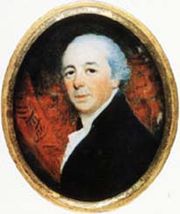
East Cowes Castle
Encyclopedia

East Cowes
East Cowes is a town and civil parish to the north of the Isle of Wight, on the east bank of the River Medina next to its neighbour on the west bank, Cowes....
, was the home of architect John Nash
John Nash (architect)
John Nash was a British architect responsible for much of the layout of Regency London.-Biography:Born in Lambeth, London, the son of a Welsh millwright, Nash trained with the architect Sir Robert Taylor. He established his own practice in 1777, but his career was initially unsuccessful and...
between its completion and his death in 1835. Nash himself was the designer of the site, and began construction as early as 1798. He was interred on the grounds.
The structure gained renown for its complex castellation, its gothic
Gothic architecture
Gothic architecture is a style of architecture that flourished during the high and late medieval period. It evolved from Romanesque architecture and was succeeded by Renaissance architecture....
-style turrets and towers, and for the notable individuals who came to be Nash's guests there, including the Prince Regent
Prince Regent
A prince regent is a prince who rules a monarchy as regent instead of a monarch, e.g., due to the Sovereign's incapacity or absence ....
and J.M.W. Turner, who painted a picture of the location.
On Nash's death, the estate was sold to the Earl of Shannon
Earl of Shannon
Earl of Shannon is a title in the Peerage of Ireland. It was created in 1756 for the prominent Irish politician Henry Boyle, who served as Speaker of the Irish House of Commons and as Chancellor of the Irish Exchequer. He was made Viscount Boyle, of Bandon, and Baron Castle Martyr at the same time,...
who added a lodge at the south of the estate. On the Earl's death in 1846 the property was sold. Its last resident, the World War II commander Field Marshal John Vereker, 6th Viscount Gort
John Vereker, 6th Viscount Gort
Field Marshal John Standish Surtees Prendergast Vereker, 6th Viscount Gort, VC, GCB, CBE, DSO & Two Bars, MVO, MC , was a British and Anglo-Irish soldier. As a young officer in World War I he won the Victoria Cross at the Battle of the Canal du Nord. During the 1930s he served as Chief of the...
purchased the estate in 1902. The first Viscount Gort
Viscount Gort
Viscount Gort is the title of two peerages in British and Irish history. Gort is a small town in County Galway in the West of Ireland. The original title was in the Peerage of Ireland and is still extant....
had years before been impressed by the castle and had commissioned Lough Cutra Castle in Ireland to a similar design by Nash.
The castle was lent to the British Army during the Second World War, under whose use the condition of the building suffered greatly and due to subsequent neglect and detoration, the castle was finally demolished in 1960. The lodge and an original icehouse survives and the castle's clock remains on display at the Carisbrooke Castle
Carisbrooke Castle
Carisbrooke Castle is a historic motte-and-bailey castle located in the village of Carisbrooke, near Newport, Isle of Wight, England. Charles I was imprisoned at the castle in the months prior to his trial.-Early history:...
Museum.

